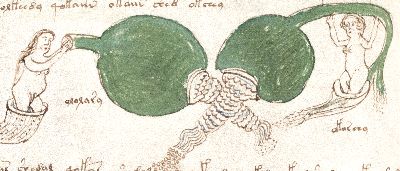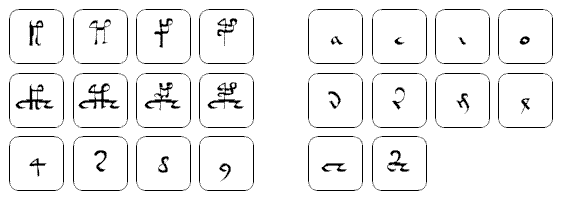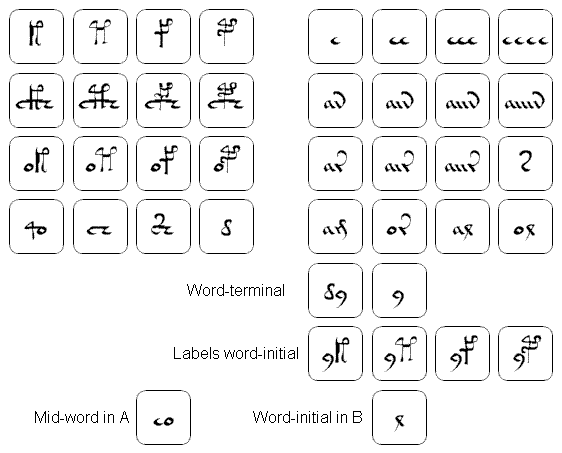Django furiously frisbee-ed his wireless mouse against the wall, but the outer shell somehow failed to shatter as it was supposed to. He kicked his oak desk: that, too, failed to break. For once, it seems he’d got lucky with eBay office furniture: and so he turned angrily back to the cryptographic fugue endlessly playing itself out on his laptop.
It was the guilt that was eating away at him: though his downloadable Voynich Manuscript mystery-cracking screensaver had started out as a half-baked idea in a bar, it had grown into a global monster with sixteen million PCs all hungrily evolving their own mad cryptological strategies, endlessly swapping and feuding over marginal etymological and historical notes.
In many ways, writing a desktop application to simulate mad conspiracy theorists had been the easy part: it was just a matter of working out an appropriate set of parameters for delusion, foolishness, distrust, and so on. However, Django had been most proud of the networking side, by which all his cryptological drones could form into mad communities – virtual bulletin boards, forums, mailing lists – and fight each other to the death. He’d always thought Nietzsche was onto something, and had relished the chance to put it into practice.
But now it had all gone bad, disastrously bad: after one particular accidental change to his infrastructure code, his army of screensaver drones had begun spilling out of the sandbox to invade the real world, posting their programmatic paranoid drivel everywhere, endlessly rewriting Wikipedia pages, sending acutely well-informed (but bizarre) letters to academics and papers, and even creating their own plausible-looking online journals.
And the big red off-button didn’t even work (yes, he’d tried).
Ever the budding ecomentalist, his five-year-old daughter had asked him how much energy the whole enterprise was wasting – how much CO2 Daddy’s ridiculous chimera was causing to be emitted every day. She was right, of course, it had to be stopped – but how? Whenever he tried to argue for the whole experiment to be shut down, he found himself being flamed beyond belief – and he couldn’t now tell whether all the abuse was coming from actual people or from his army of paranoiac screensaver drones.
But even that wasn’t the worst thing – not by a long way.
Terrifyingly, even though he hadn’t programmed the drones to agree, in the last few weeks they had begun to eliminate the worst theories – even mad drones could agree on Popperian falsification, it would seem. But nobody apart from Django knew this was happening: to uninformed eyes, the screensaver pattern he had written to show the status of the enterprise looked simply like strange pulsing, rippling, 3D eye-candy – but through it, he could visualize the internal ebbs and flows of opinion within the self-organizing communities.
To be precise, he alone could now see that a trillion trillion mad theories had somehow been whittled down to just two dominant positions – hoax theorists versus Leonardo da Vinci theorists: and with roughly eight million drones on each side of the argument, it couldn’t have been more polarized (or more bitter). What was acutely worrying was that, because the hoax drones were centred on the US while the Leonardo drones were centred in Europe, they were starting to physically mobilize against each other.
First to strike had been the hoax drones, knocking out several European Internet backbones, trying to disrupt the Leonardo drone communities’ lines of communications – but the Vinci-ites had then mounted a surprise attack on the GooglePlex, disrupting the hoax drones’ main information spigot. When Django tried to get the word out what was going on, both sides reduced his Internet access to a dribble – and even overrode the automatic locks on his doors. He and his family were trapped in their mid-town apartment, helplessly watching as Fox News told the world of the bizarre terrorist cyber-war going on, updated every fifteen minutes.
And with the Western world on the brink of a kind of cryptographic Armageddon, the pattern in his laptop was now changing again – but what would happen next? Django could see that the swirling clouds of pixels were morphing from a figure-eight arching around the two strange attractors into a single perfect loop of opinion – that the Voynich Manuscript was Leonardo da Vinci’s incredible hoax. Finally, the computers had spoken their collective mind – and as the sixteen million paranoid silicon bots agreed on a single, wretched, stupid theory, the whole project juddered to an awful, stagnant halt.
Once again, he tried shutting the project down: but this time round, it actually seemed to want to die, to embrace the silent darkness of non-existence. Django collapsed onto the carpet just as sixteen million screensavers all went black, as all the mad minds he had brought to life came to believe they had reach a tentative peace in their programmatic hearts, by somehow converging on a deeper truth.
(Never mind that it was a crock.)



